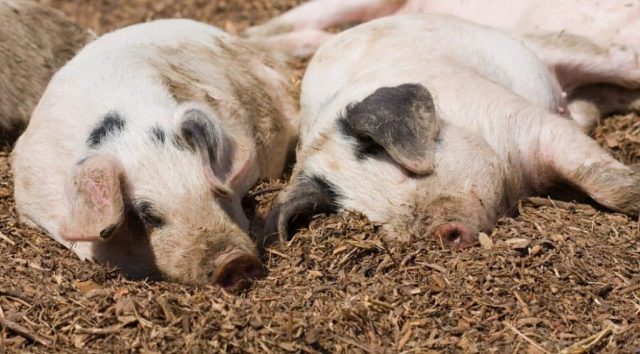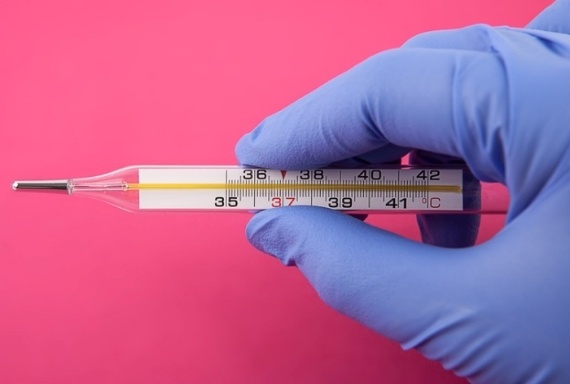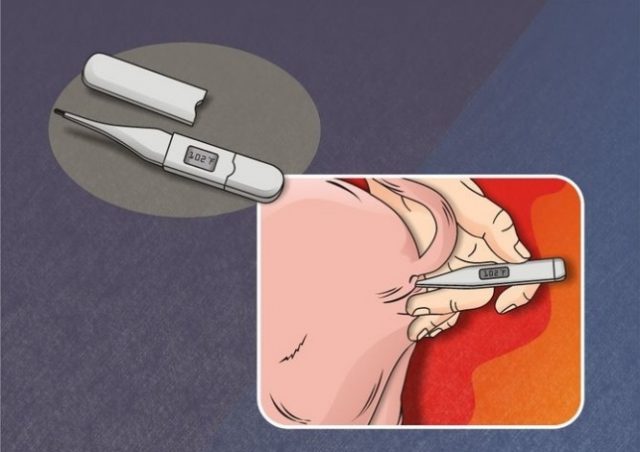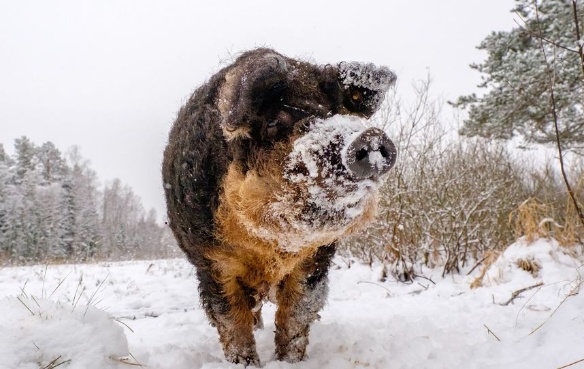Content
The pig's body temperature is the first signal of disease. Almost all serious illnesses are accompanied by a high fever. But there are also those that are characterized by a decrease in temperature. The latter are usually not contagious, but can also lead to the death of the pig.
What is the normal temperature in pigs?
We can immediately say that the normal temperature in small breeds of pigs is the same as in large ones. Animals really have this interesting point: the smaller the mammal, the hotter it is. But this does not apply to pigs. Except, perhaps, only for mini pigs. Not Vietnamese pot-bellies, which are slightly inferior in weight to large pigs, but real mini-pigs. The latter were bred specifically for decorative purposes, are very small in size and have a lot of genetic problems. The body temperature of such decorative pigs can indeed be half a degree higher.
All other breeds, including Vietnamese pigs, body temperature normally ranges from 38 ° C to 40 ° C. Pigs hold the record for temperature among domestic animals. They share first place with sheep and goats. Piglets try not to embarrass their parents.
What is the normal temperature for piglets
It is often more important for the sow owner to know the normal temperature of the piglets than of the sow, so as not to miss the onset of "childhood" diseases. Here again the principle common to all mammals operates: young animals are always hotter than adult animals. Accordingly, the normal body temperature of piglets is in the range of 39-40.5 ° C.
And here the internal temperature should not be confused with the external one. The skin is an organ, one of the functions of which is thermoregulation. In cold air, it becomes cool, as blood from the epidermis goes inward to keep warm. In the heat, the skin becomes hotter than the internal organs. It is heated by the blood that "rises" to the skin to give off excess heat, and too warm air.
In pigs, thermoregulation is carried out in a similar manner, correcting for subcutaneous fat. Young pigs do not yet have a sufficient fat thickness, and they are more sensitive to environmental conditions. Therefore, the skin temperature of the piglet is quite dependent on the room temperature. The colder it is in the room, the more the pig freezes, and the colder his skin.
Signs of malaise
For preventive purposes, you need to measure the temperature at least once a week. Daily examination helps to identify deviations in the behavior of animals. Such deviations often arise as a result of ailments and are sometimes noticeable only to the owner who knows his animal well. If a choleric pig, constantly trying the fence for strength, suddenly stops disassembling its machine, it is worth checking its health. Or a phlegmatic person, revived only at the sight of food, suddenly rushes around the pen.Most likely, the source of such arousal is by no means a good mood.
Clear signs of problems in which the veterinarian is called on the way from the pigsty to the house:
- apathy;
- strong excitement;
- rash on the body;
- diarrhea;
- constipation;
- half-eaten food;
- vomiting;
- muscle tremors;
- unsteadiness of gait;
- hard breath;
- red eyes;
- fast heartbeat;
- hot patch and ears (can be like this right after waking up);
- dull bristles standing on end;
- attempts to burrow into the litter.
The doctor can be intimidated with something serious, otherwise it is not a fact that he will arrive quickly. While the veterinarian is driving, you need to have time to bring a thermometer from home and measure the temperature of suspicious pigs.
List of possible causes of temperature rise
There is only one reason for the increase in overall body temperature - the body's fight against infection. But there are a lot of diseases that can cause pathogens and viruses. Any infectious swine disease falls into the list of reasons.
The body temperature of the pig rises:
- with complications after castration, when the wound begins to fester;
- gastritis;
- gastroenteritis;
- other internal non-communicable diseases.
Most often, any serious inflammatory process is accompanied by an increase in overall body temperature.
How can you measure body temperature in a pig and a piglet?
With a high degree of reliability, the temperature of any animal can be measured only by inserting a thermometer into the anus. Any other methods give a high percentage of error. Measurements at a distance using an infrared sensor only let you know how hot the surface of a mammal's skin or coat is.
Measurement methods
In a pig, the temperature is also measured at the anus. But these animals are nervous and do not always trust their owners. It is good if the pig calmly allows her to insert a thermometer into her anus. And if she's half-wild, it's harder.
How to correctly measure the temperature of a pig
Hope for the best, but count for the worst. In an ideal situation, the pig's tail is raised, a thermometer is inserted into the anus and waits for the required time, not forgetting to hold the thermometer.
The anus has an unpleasant tendency to "suck" too deeply inserted objects into itself. A deep immersed thermometer the pig can "eat" by the rear end. After that, the sphincter will close, and it will be impossible to get the thermometer. There are recommendations to fix a ribbon or thin string with an adhesive plaster on the top of the thermometer. Then for this tape it will be possible to extract the thermometer from the anus of the animal.
The video below shows a "perfect" measurement of body temperature in a pig with a mercury thermometer. The owner's only mistake: he lets go of the thermometer. He was lucky that the pig did not pay attention to such an oversight. Some animals simply push the measuring device outward. This is better than being sucked in, but the thermometer may break.
An imperfect temperature measurement will be in the event that the pig is semi-wild. A relatively small pig can still be caught, knocked down and held by force. With an adult pig, this will no longer work. Such a pig gets entangled and knocked to the ground. They are waiting for her to calm down, and a thermometer smeared with petroleum jelly is carefully inserted into the anus. Again they listen to everything she thinks about people.
Wrong ways
To make life easier for themselves or out of disgust, some owners try to measure the body temperature of a pig by attaching thermometers outside. There are two ways: glue the thermometer with adhesive tape and place it between the back leg and the belly of the pig. Something like how people measure their temperature by holding a thermometer under their armpits.
The second method is better, but it does not give the correct result either.Since initially thermometers were placed exclusively in the anus, the body temperature of pigs is indicated based on these data. But the "outdoor" thermometer shows 1 ° C lower. If the normal temperature of the pig is 39 ° C, the thermometer will show 38 ° C. It doesn't matter. But with a fever, instead of 40.5 ° C, the owner will receive data at 39.5 ° C. While the pig is in a fever of illness, the owner will think the animal is healthy.
Gluing the thermometer to the pig's skin with an adhesive plaster will give even more inaccurate results. There will be air on one side of the thermometer, skin on the other. It's good if mercury or sensors of an electronic thermometer show at least the lower limit of the norm. It is more likely that the measurement will show the temperature of the cooling corpse.
Measuring with an infrared thermometer cannot be called the wrong way. It's more likely just getting the wrong data.
Types of measuring instruments
Previously, there was only one medical thermometer: mercury. Today, a group of thermometers has appeared, which are called digital. This group is divided into two: electronic and infrared.
Mercury thermometer
The most famous and oldest type. Made of glass. The inner tube is filled with mercury. Pros: low cost and high accuracy. Cons: high risk of breaking the device.
The measurement time in the anus in animals is actually only 2-2.5 minutes. Declared 10 minutes. indicated for measuring the temperature of a person in the armpit.
Mercury has a good feature: the hotter the organism, the faster the column of mercury crawls upward. Since the temperature of healthy pigs is "perceived" by the thermometer as heat in humans, mercury creeps up very quickly. And "creeps" to the final result the faster, the higher the mercury column was initially. Since the normal temperature of pigs cannot be lower than 38 ° C, it makes no sense to bring down the mercury "to zero". It is enough to shake off the indicators to 37 ° C.
Digital Thermometer
The measurement methods of this device are the same as those of mercury. Even the shape of these two types is similar. But instead of mercury in an electronic thermometer, sensors are used, the data from which are displayed on a liquid crystal display. An electric battery is required to operate the device. The measurement time lasts 1.5-2 minutes. The thermometer signals the end of the procedure with a sound.
Of the pros:
- this type of thermometer is difficult to break;
- even if you break it, nothing terrible will happen;
- no need to keep track of the time;
- the device is relatively wide and it is more difficult to "suck" it.
Cons:
- the price is slightly higher than that of mercury;
- the readings may turn out to be incorrect, since some models must be kept for a few minutes after the signal.
But in general, an electronic thermometer gives accurate data.
Infrared thermometer
It also requires an electric battery to operate. The sensors of the device also display data on the liquid crystal screen. But this device is capable of taking measurements from a distance. At first glance, this property seems to be a serious advantage. In fact, this is a disadvantage. The sensors show the temperature not inside the body, but on its surface. That is, the owner, at best, learns how cold the skin of his animals is. At the same time, the skin may be overheated in the sun or chilled in a puddle and not signal the pig's true health.
In the worst case, the device will show the temperature of the bristles. In the Hungarian Mangalitsa in winter, the indicators will be close to zero or even negative.
Despite the seeming convenience and speed of use, an infrared thermometer is not well suited for working with animals, since the temperature in pigs is the first symptom of the disease, and sometimes treatment must be started immediately. An infrared thermometer is best used for taking readings and an open-hearth furnace.
The disadvantages of such a thermometer are the same as those of a mercury one: you must be able to catch a pig. Pros - the pig does not need to be knocked down, and you only need to hold it for a few seconds to take readings.
What to do if a piglet has a high fever
Ideally, you should call your veterinarian right away. But the ideal in life is rare. For a piglet, the upper limit is 40.5 ° C. Animals can hardly tolerate high temperatures, therefore, if the upper limits are exceeded, do not delay and wait a day, counting on "it will pass by itself." The sooner the disease is "caught", the less harm it will cause and the easier it is to cure it.
In addition, it "goes away by itself" very often with edematous disease of piglets - the scourge of the pig breeder. First, the temperature "passes by itself", and then the piglet dies.
If there is absolutely no way to call a veterinarian, the piglets are given antipyretic drugs and antibiotics are pierced. Penicillins and tetracyclines are commonly used.
What to do if a pig has a high fever
The limiting temperature of the pig is lower: 40 ° C. Higher rates also indicate the onset of the disease. Almost all diseases in pigs and piglets are common. Unless adults already suffer from enterotoxemia. Accordingly, the actions at elevated body temperature in a pig are the same. But the dosage of drugs is different and depends on the weight of the animal.
Low fever in pigs: symptoms and treatment
The main reason for the lowered temperature in pigs is intoxication of the body. Signs of a low temperature:
- chills;
- cold limbs;
- cold ears;
- the pig's tendency to bury itself in a warm bed to keep warm.
Poisoning occurs not only when eating poisonous and poor quality feed. Poisonous substances can enter the bloodstream when:
- helminthiasis;
- overdose of anthelmintic drugs;
- due to the large number of waste products of pathogenic microorganisms;
- intestinal blockages;
- constipation;
- problems in the genitourinary system;
- non-infectious hepatitis;
- kidney disease.
Chills were noted in a pig with rickets. But they didn't measure his temperature, he could just be weakened. A low temperature in a pig is not a symptom of rickets and treatment at home is better not to be limited only to letting the animal out into the sun. At low temperatures, it is also better to invite a veterinarian, and give the pig a laxative as first aid. But only if the piglet did not get sick after deworming. In severely worm piglets, after an anthelmintic drug, massive death of parasites in the intestines can occur. A ball of dead worms clogs the gastrointestinal tract and begins to decompose, causing poisoning in the pig's body.
Conclusion
Pig body temperature is one of the main parameters that must be monitored constantly. Sometimes it is possible to miss a sharp rise and subsequent decrease in temperature to normal, losing the entire brood of piglets.















